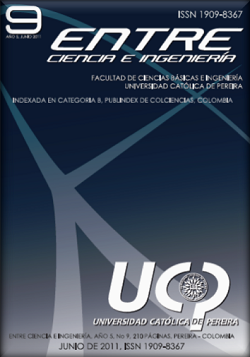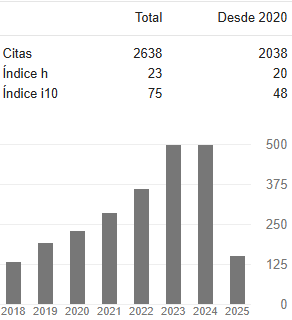Correlation Between Plasma and Copper thin Films Properties Grown by Laser Ablation
DOI:
https://doi.org/10.31908/19098367.702Keywords:
Optical Emission Spectroscopy, growth of thin films, laser ablation, Cu, Raman, SEM.Abstract
Optical emission spectra of plasma copper were obtained and they have been studied using optical emission spectroscopy, these plasmas were produced by a Nd: YAG pulsed laser (1064 nm, 9 ns, 500mJ) and at laser fluence 7 J/cm2. With the copper’s plasmas have been thin films grown over an amorphous substrate (glass) at room temperature. The argon gas pressure has changed to 9 mTorr, 100 mTorr, 150 mTorr and 200 mTorr. The 480-530 spectrum range line spectral were identified, the characteristic green color of copper plasma is obtained from the most intensities spectral lines. These spectra are dominated by neutral copper (Cu I) followed by ion copper (Cu II). The intensities lines increases as pressure increases, due to the plasma is confined by gas pressure, increasing the collisions number between different species increasing ionized species. The Raman spectra of copper thin films at different gas pressure show some peaks between 367 cm-1 and 602 cm-1, these peaks are associated with to Cu-O bonds. It suggests the easy process of oxidation of metallic Copper, these spectra have a redshift that can be interpreted as the effect of phonons in the crystal lattice of the film. The morphological analysis of the films by SEM shows that films are soft, smooth and profilometry results are corroborated ultrathin films.
Downloads
References
Amoruso, S. (2004), “Diagnostics of laser ablated plasma Plumes”, Thin Solid Films; pp. 562-572.
Chen, A. (2008, Octubre), “Controlled growth and characteristics of single-phase Cu2 O and CuO films by pulsed laser deposition”, Vacuum, núm. 83; pp. 927-930.
Chrisey, B., Hubler, G.K. (1994), Pulsed Deposition of Thin Films, New York: Wiley.
Franco, L. (2008). Estudio espectroscópico de plasama del aire cobre y aluminio producidos por láser. Colombia: Universidad Tecnlógica de Pereira, Trabajo de grado.
Gonzales-Hernández, J., Pérez- Robles, J. F. (2000, Diciembre) “Vidrios SiO 2 nanocompuestos preparados por sol-gel: revisión”. Superficies y Vacío. núm XI, pp. 1-16.
Li, Z., Rahtu, A. And Gordon, R. “Atomic Layer Deposition of Ultrathin Copper Metal Films from a Liquid Copper (I) Amidinate Precursor”. Journal The Electrochemical Society. pp 153
Lindroos, S, Ruuskanen, T, Ritala, M, Leskela, M. (2004), “Growth, of Cu thin films by the successive ionic layer adsorption and reaction (SILAR) method”, Thin Solid Films, núm. 460, pp. 36–40.
Nemet, B. and Kozma, L. (1995), “Time-resolved optical emission spectrometry of Q-switched Nd:YAG laser- induced plasmas from copper targets in air at atmospheric pressure”. Spectrochimica. Acta Part B, pp.1869-1888.
Pfleging, W. (1996, Julio), “Excimer-laser patterning of copper in LDE “laser dry etching”, Applied Surface Science, pp. 194-200.
Smith, H. M. and Turner, A. F. (1965), “Vacuum deposited films thin using a ruby laser”, Applied Optics. núm 4, pp. 147.
Wei, T. (1990, Diciembre), “Raman Scattering of cupric oxide (CuO)”, Simon Fraser University. pp 1-99
Xuelian, Q., Chunsheng, R., Tengcai, M. and Younian, W. (2008, Junio), “Cu Films Deposited by Unbalanced Magnetron Sputtering Enhanced by ICP and External MagneticField Confinement”. Plasma Science and Technology, Vol. X, núm 3, pp 319-322.
Downloads
Published
Issue
Section
License
Copyright (c) 2019 Entre ciencia e ingeniería

This work is licensed under a Creative Commons Attribution-NonCommercial 4.0 International License.



















